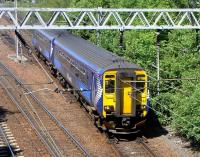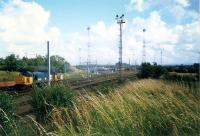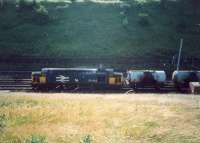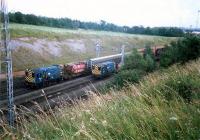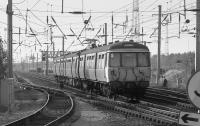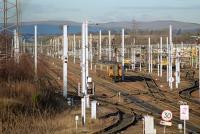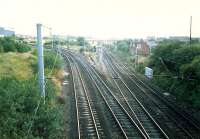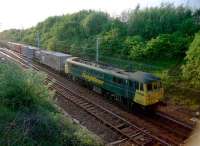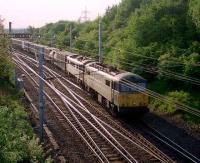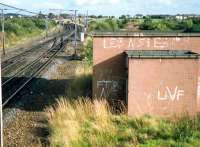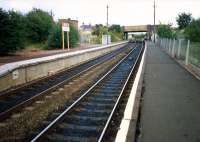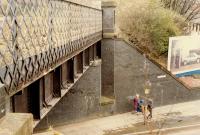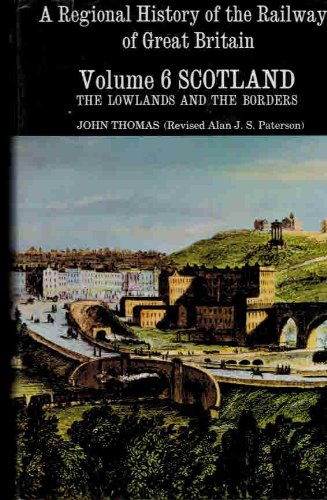Wishaw and Coltness Railway
Introduction
This line is largely open. It was initially called the Glenturk and Garion Railway. Today it is a part of the West Coast Main Line between Motherwell and Wishaw. The line was planned to run from Coatbridge to Jerviston to Wishaw. A branch from Jerviston to Cleland was added, which opened first. Further lines went on to Morningside. Closed sections run in Cleland and from Wishaw to Morningside via Coltness.
Why built
The line was built by landowners to serve their estates and the needs of local industry. The Coltness Iron Works was at the south east end of the line and many mines were served en route.
Dates
| / /1829 | Wishaw and Coltness Railway Act receives Royal assent. Line gauge was 4ft 6in and was extended slowly south from Whifflet and Carnbroe Iron Works to the Coltness Iron Works Railway and the Chapel Colliery. A branch was authorised to Newarthill to meet the Omoa Iron Works Railway. Further authorised branches to Rosehall and Law were not built. |
| / /1834 | Wishaw and Coltness Railway An extension of time stipulated in the Act for the construction is required. |
| 25/01/1834 | Wishaw and Coltness Railway First portion of line opened from Whifflet to Holytown [1st] for minerals. (This portion included the Holytown Tunnel south of Carnbroe.) |
| 31/05/1834 | Wishaw and Coltness Railway
Monkland and Kirkintilloch Railway
Garnkirk and Glasgow Railway Cleland Branch, Holytown [1st] to Newarthill, opened for minerals. (Not long afterwards a passenger service from Newarthill with the carriage joining Glasgow Townhead trains at Gartsherrie [GGR] was introduced. It ran from Newarthill in the morning and back in the afternoon/evening.) |
| / /1835 | Wishaw and Coltness Railway Company first pays Passenger Duty. This implies that passengers were already being carried and would continue to be carried. Details are inconsistent from different sources. As are opening dates of sections. |
| / /1837 | Wishaw and Coltness Railway A further extension of time allowed to complete works. Line authorised to use locomotives through the Jerviston Estate - the company and Houldsworths of the Coltness Iron Works buying the rights. |
| 18/08/1838 | Wishaw and Coltness Railway Extension south from Holytown [1st] to Jerviston (the later area of Jerviston Junction) opened to minerals. Opening delayed by the construction of the Jerviston Viaduct. |
| 20/03/1841 | Wishaw and Coltness Railway Jerviston (near the later Jerviston Junction) to Overtown Road opened. |
| /10/1841 | Wishaw and Coltness Railway Line completed to Chapel near the Coltness Iron Works. The iron works used the railway to transport its pig iron. |
| 08/01/1842 | Wishaw and Coltness Railway Extended from Overtown Road to Carluke [1st] (later Stirling Road) for minerals. (Date is inconsistent with the Chapel opening of 1841 - Chapel was further on from Stirling Road.) |
| /02/1843 | Glasgow, Garnkirk and Coatbridge Railway Garnkirk and Glasgow Railway extended from Gartsherrie to new Coatbridge [CR], initially a terminus. (This line later extended through to Whifflet South Junction and was used by the Wishaw and Coltness Railway and the Caledonian Railway to avoid the more tortuous Monkland and Kirkintilloch Railway route with level crossings through Coatbridge.) |
| 08/05/1843 | Wishaw and Coltness Railway A new passenger and goods service started. Called at; Morningside [CR] (from 1844), Carluke [1st], Overtown Road, Wishaw [1st], Motherwell [1st], Holytown [1st], Carnbroe and (after 1845 when its southern approach opened) Coatbridge [CR] (Glasgow, Garnkirk and Coatbridge Railway). There was a through coach to Glasgow. An omnibus ran from Carluke [1st] to Lanark. |
| / /1844 | Wishaw and Coltness Railway Use of locomotives confirmed. |
| / /1844 | Rosehall Railway
Wishaw and Coltness Railway Rosehall Crossing at Whifflet authorised. |
| 09/03/1844 | Wishaw and Coltness Railway Extended from Carluke [1st] to Morningside [1st]. |
| /07/1844 | Garnkirk and Glasgow Railway
Glasgow, Garnkirk and Coatbridge Railway With the extension to Coatbridge [CR] in use the line is renamed the Glasgow, Garnkirk and Coatbridge Railway. An Act of Parliament authorises the Gartsherrie to Summerlee Iron Works and Coatbridge section along with the extension to the Wishaw and Coltness Railway at Whifflet. Alteration of the gauge is also authorised. |
| / /1845 | Clydesdale Junction Railway Act receives Royal assent. The line was authorised from Glasgow, using the Polloc and Govan Railway to reach Hamilton with a branch to Motherwell [1st], the forks dividing at the later Newton station. The line would bring coal from pits in the Hamilton area, owned by the Dixons amongst others, to the Govan Iron Works. The Motherwell branch was authorised to not to be opened until the Caledonian Railway reached the Wishaw and Coltness Railway. |
| 29/03/1845 | Edinburgh and Glasgow Railway
Monkland and Kirkintilloch Railway
Ballochney Railway
Slamannan Railway At the instigation of the Edinburgh and Glasgow Railway the Monkland and Kirkintilloch Railway, Ballochney Railway and Slamannan Railway pool their receipts. The Wishaw and Coltness Railway did not get involved. |
| 14/07/1845 | Glasgow, Garnkirk and Coatbridge Railway Extended from Coatbridge [CR] to Whifflet South Junction. Whifflet [CR] station opened. The Wishaw and Coltness Railway passenger service to Glasgow Townhead ceases to use the Monkland and Kirkintilloch Railway to reach Gartsherrie and is diverted via Coatbridge [CR]. |
| /10/1845 | Edinburgh and Glasgow Railway
Wishaw and Coltness Railway The Edinburgh and Glasgow Railway agrees to buy the Wishaw and Coltness Railway. |
| / /1846 | Wishaw and Coltness Railway Locomotives provided by R. & W. Hawthorn of Newcastle from 1846 to 1848. |
| / /1846 | Wishaw and Coltness Railway Branch authorised to Goodockhill. (Not built. Served by the Legbrannock Railway Extension and later served by the Salsburgh Branch (Caledonian Railway).) |
| / /1846 | Wishaw and Coltness Railway Proposed Murdieston branch abandoned. |
| /01/1846 | Edinburgh and Glasgow Railway
Monkland and Kirkintilloch Railway
Wishaw and Coltness Railway Service from Morningside [1st] to Glasgow Townhead is diverted over the Monkland and Kirkintilloch Railway to reach Glasgow Queen Street. |
| /12/1846 | Edinburgh and Glasgow Railway Wishaw and Coltness Railway The Edinburgh and Glasgow Railway decided not to buy the Wishaw and Coltness Railway, which immediately enters discussions with the Caledonian Railway. |
| / /1847 | Wishaw and Coltness Railway Converted to standard gauge. |
| 01/01/1847 | Wishaw and Coltness Railway
Caledonian Railway The Wishaw and Coltness Railway is leased to the Caledonian Railway. Trains from Morningside [1st] station are diverted from Glasgow Queen Street to Glasgow Townhead. |
| / /1848 | Wishaw and Coltness Railway Deviation and improvement, between Garriongill Junction and Whifflet and with new curve at Carnbroe, authorised. |
| 15/02/1848 | Caledonian Railway Beattock to Glasgow (Townhead) (via the Wishaw and Coltness Railway and the Glasgow, Garnkirk and Coatbridge Railway) and Edinburgh (Lothian Road) branch opened. The stations at Abington and Elvanfoot, on its main line, are used by the lead mines and villages at Leadhills and Wanlockhead. |
| / /1849 | Wishaw and Coltness RailwayCaledonian Railway Wishaw and Coltness Railway merged with Caledonian Railway. |
| / /1851 | Wishaw and Coltness Railway Caledonian Railway creates Wishaw and Coltness Railway Guarantee Company. |
| / /1854 | Wishaw and Coltness Railway Authorisation to open out Carnbroe Tunnel. |
| / /1854 | Wishaw and Coltness Railway Authorisation to open out the Holytown Tunnel. (Associated with other improvements such as the Motherwell Deviation (Caledonian Railway) authorised in the same year.) |
| / /1855 | Wishaw and Coltness Railway Holytown Tunnel opened out. |
| 08/10/1857 | Motherwell Deviation Line (Caledonian Railway) Line opened from Jerviston Junction (Wishaw and Coltness Railway) to Lesmahagow Junction (Clydesdale Junction Railway). The line allowed Motherwell [1st] station to be moved further west to Motherwell atLesmahagow Junction. Motherwell [1st] remained standing and Motherwell was opened in the V of the junction at Lesmahagow Junction. A large viaduct was required, Braidhurst Viaduct. |
| / /1859 | Wishaw and Coltness Railway Fully vested in the Caledonian Railway. |
| 01/12/1864 | Cleland to Morningside Line (Caledonian Railway)
Salsburgh Branch (Caledonian Railway) Extension of the former Wishaw and Coltness Railway's Cleland Branch to Morningside [CR] (Newarthill and Morningside Branch) opened to goods. |
| / /1865 | Wishaw and Coltness Railway Authorisation to widen the railway at Holytown Junction [1st]. This was around the time of the authorisation of the Cleland and Midcalder Line (Caledonian Railway). |
| / /1872 | Wishaw and Coltness Railway New Stevenston Level Crossing authorised to be shut up. |
| / /1874 | Wishaw and Coltness Railway New Stevenston Level Crossing closed. This level crossing on Jerviston Street was just west of Holytown station. It was replaced by both a footbridge at the former crossing and a new road bridge further west carrying Stevenston Street. |
| / /1875 | Rosehall Railway
Wishaw and Coltness Railway Rosehall Crossing at Whifflet closed and northern portion of Rosehall Railway closed with the opening of a new connection avoiding both the level crossing and Rosehall Tunnel. Rosehall Connections (North British Railway) opened from the Glasgow, Bothwell, Hamilton and Coatbridge Railway. |
| 01/10/1878 | Wishaw and Coltness Railway Sidings laid in to the rebuilt Mossend Iron and Steel Works. |
| 01/06/1880 | Wishaw and Coltness Railway Wishaw [1st] re-named Wishaw South. |
| 01/10/1881 | Wishaw and Coltness Railway Overtown [1st] closed. |
| 02/03/1891 | Wishaw and Coltness Railway Flemington station opened. |
| / /1901 | Glasgow, Garnkirk and Coatbridge Railway
Wishaw and Coltness Railway Whifflet Low Level widening authorised. |
| / /1904 | Wishaw and Coltness Railway Motherwell Gas Works siding authorised. |
| / /1909 | Glasgow, Garnkirk and Coatbridge Railway
Wishaw and Coltness Railway Extension of time for Whifflet Low Level widening until 1912. |
| 27/12/1917 | Wishaw and Coltness Railway Agreement between the Caledonian Railway and David Colville and Sons over alteration to Park Street Level Crossing entry. |
| 15/09/1958 | Wishaw and Coltness Railway Wishaw South closed. |
| /04/1970 | Caledonian Railway Wishaw and Coltness Railway Clydesdale Junction Railway Polloc and Govan Railway Glasgow Central Station (Caledonian Railway) West Coast Main Line electrification authorised. |
| 06/05/1974 | Caledonian Railway
Wishaw and Coltness Railway
Clydesdale Junction Railway
Polloc and Govan Railway
Glasgow Central Station (Caledonian Railway) Glasgow Central to Carlisle electrification complete. |
| 11/08/1981 | Garnkirk and Glasgow Railway
Wishaw and Coltness Railway Coatbridge Freightliner Terminal to Mossend Marshalling Yard electrified. |
| / /2000 | Coltness Iron Works Railway Wishaw and Coltness Railway Costain's Coltness Concrete Works closed. |
| / /2000 | Wishaw and Coltness Railway Works begins to relay the line from Stirling Road Junction to the Watsonhead Loading Pad (near the former Morningside [CR] station) for opencast coal traffic. |
| / /2004 | Wishaw and Coltness Railway Traffic ceases about this date at the Watsonhead Loading Pad. |
| / /2015 | Wishaw and Coltness Railway Garriongill Junction taken out. |
| / /2018 | Wishaw and Coltness Railway Carfin platforms extended. |
Portions of line and locations
This line is divided into a number of portions.
Whifflet to Omoa
This junction is to the south of Whifflet station. It was formed in 1845 when the 1834 portion of the Wishaw and Coltness Railway was met by the Whifflet Extension (Glasgow, Garnkirk and Coatbridge Railway).
...
See also
Whifflet Extension (Glasgow, Garnkirk and Coatbridge Railway)
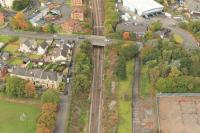
Network Rail /08/2022
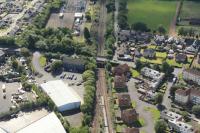
Network Rail /08/2022
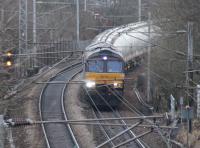
Alastair McLellan 15/12/2016
This was the junction from which the 1828 Monkland and Kirkintilloch Railway was extended south in 1834 by the Wishaw and Coltness Railway, leaving the route to Palacecraig on a branch. From the same junction the Rosehall Railway ran south to the Rosehall Colliery.
...
See also
Monkland and Kirkintilloch Railway
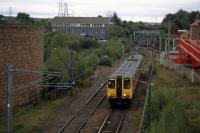
John Clark //1995
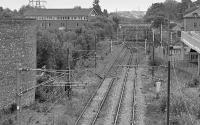
Bill Roberton //2001
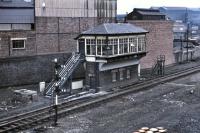
Bill Jamieson 07/03/1971
This was a short lived halt by the Carnbroe Iron Works.
...
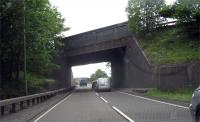
Michael Gibb 27/06/2010
Calder Iron Works signal box controlled the southern approach to the Calder Iron Works from the Wishaw and Coltness Railway. The works approach was on the east side of the line and approached from the south. The junction was located on a bridge over the North Calder Water. The signal box was on the east side and just to the south of the junction.
...
This signal box was on the west side of the Wishaw and Coltness Railway. It controlled access to Calder Iron Works and Carnbroe Iron Works and replaced both Calder Iron Works Signal Box [CR] and Carnbroe Iron Works Signal Box in 1914.
...
This signal box was on the east side of the Wishaw and Coltness Railway to the south of where the sidings of the Carnbroe Iron Works joined the main line. The works was approached from the south.
...
This signal box was between Carnbroe North Signal Box and Burnhouse Weighs Signal Box. It was on the west side of the line. Just to the east was Orchard Farm. It opened in 1900 (earlier than the north box which opened in 1914).
...
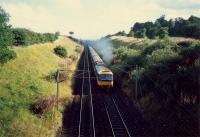
Ewan Crawford //1987
This tunnel was in the Carnbroe Estate and was opened out in 1855. It was on the Wishaw and Coltness Railway between, using modern references, the M8 (to the north) and Mossend Marshalling Yard (to the south). The tunnel may have been twin bore. Known as either Holytown or Carnbroe Tunnel.
...
See also
Mossend Marshalling Yard (Caledonian Railway)
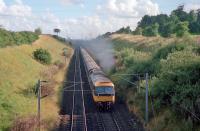
Ewan Crawford //1987
This junction and signal box was at the north end of what became Mossend Marshalling Yard.
...
This large yard spans both sides of the railway at Mossend. Today the yard consists of loops on either side of the line with freight depots on the west side and a fenced Euroterminal depot on the east side.
...
See also
Mossend Marshalling Yard (Caledonian Railway)
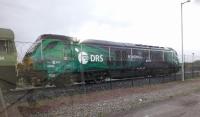
John Yellowlees 09/11/2021
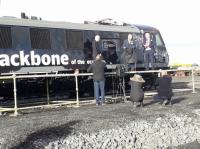
John Yellowlees 09/11/2021
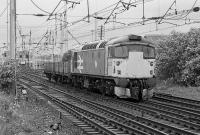
Bill Roberton //1990
This junction is just north of the former Mossend station and just south of Mossend Marshalling Yard.
...
See also
Mossend Marshalling Yard (Caledonian Railway)
Uddingston Junction to Fullwood Junction (Caledonian Railway)
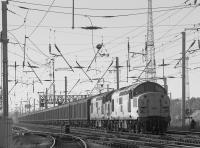
...
Bill Roberton //1992
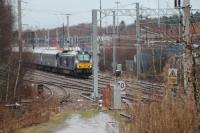
Alastair McLellan 06/03/2019
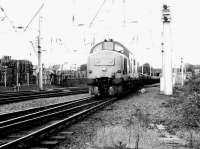
John Furnevel 01/07/1996
This station was at the south end of Mossend Marshalling Yard. Holytown [1st] station closed when this station, just to its north, opened with two platforms on the line south and east and a further two platforms on the west to north curve of the Mossend junctions.
...
See also
Mossend Marshalling Yard (Caledonian Railway)
Uddingston Junction to Fullwood Junction (Caledonian Railway)
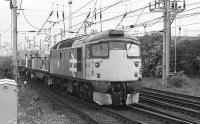
Bill Roberton //1990
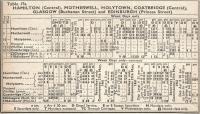
David Panton 12/09/1960
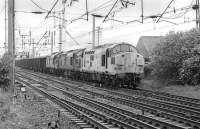
Bill Roberton 07/06/1990
This is a double track junction between the line north to Coatbridge Central and south to Motherwell and the line east to Shotts. It is just to the south of the Mossend Marshalling Yard. This the the northern of the Mossend junctions.
...
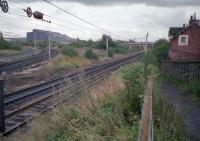
Ewan Crawford //1987
This is a three way junction south east of the Mossend Marshalling Yard on the Glasgow Central - Shotts - Edinburgh Waverley route.
...
See also
Uddingston Junction to Fullwood Junction (Caledonian Railway)
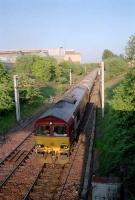
Ewan Crawford //2001
This is a minimal two platform station. There is a car park on the north side.
...
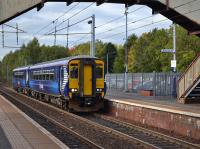
Bill Roberton 28/09/2018
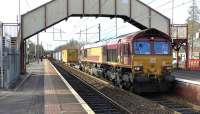
Ken Browne 09/03/2017
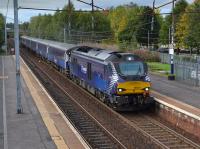
Bill Roberton 28/09/2018
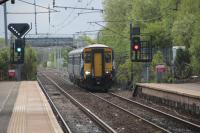
Alastair McLellan 03/05/2019
This junction is east of Holytown station. The lines to Edinburgh via Midcalder Junction and Carlisle via Law Junction divide here, the latter being a Motherwell bypass, ideal for limited stop trains and freight from the Mossend Marshalling Yard.
...
See also
Wishaw Deviation (Caledonian Railway)
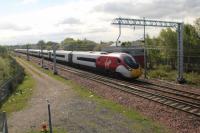
...
Alastair McLellan 03/05/2019
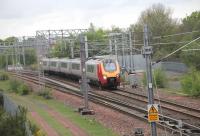
See
Alastair McLellan 03/05/2019
This is a two platform station with a car park on the south side. the car park was formerly the goods yard and featured a large double height loading bank with two faces.
...
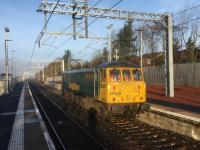
Iain Teaz 24/02/2019
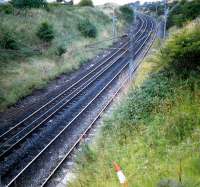
Ewan Crawford //1987
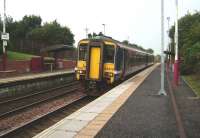
David Panton 17/09/2008
This junction was formed in 1869 when the Cleland and Midcalder Line (Caledonian Railway) opened. It met the much older 1834 Wishaw and Coltness Railway Cleland branch here, built to serve collieries and the Omoa Iron Works (1789-1868).
...
See also
Cleland and Midcalder Line (Caledonian Railway)
Mossend to Morningside
This is a double track junction between the line north to Coatbridge Central and south to Motherwell and the line east to Shotts. It is just to the south of the Mossend Marshalling Yard. This the the northern of the Mossend junctions.
...

Ewan Crawford //1987
This station was located close to today's Mossend North Junction and the Mossend Marshalling Yard.
...
At Milnwood Junction, just south of the former Holytown [1st] and south of the former Mossend station and Mossend Marshalling Yard, lines from Bellshill, Mossend and Holytown meet. To the south was Jerviston Junction and the lines to Clydesdale Steel Works.
...
See also
Clydesdale Steel Works Railways
Uddingston Junction to Fullwood Junction (Caledonian Railway)
Motherwell Deviation Line (Caledonian Railway)
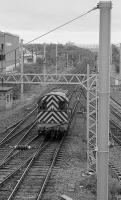
...
Bill Roberton //1988

Ewan Crawford //
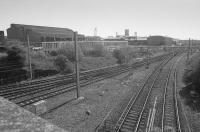
Bill Roberton 01/05/1991
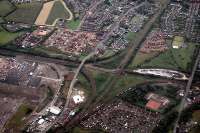
Ewan Crawford //
This junction was north of Jerviston Viaduct. It was the junction between the Wishaw and Coltness Railway and a colliery branch to a coal pit at Cleekhimin.
...
See also
Motherwell New Lines (Caledonian Railway)
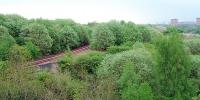
Ewan Crawford 10/05/2008
This was a ten arch single track wooden viaduct over the South Calder Water. The piers were stone. The viaduct was on the course of the Wishaw and Coltness Railway. Also known as the Camp Viaduct or Germiston Viaduct.
...
This station was located on the Wishaw and Coltness Railway where it was met by the Clydesdale Junction Railway. The station was just east of the junction.
...
See also
Clydesdale Junction Railway
The first, and short lived, station in Motherwell was on the Wishaw and Coltness Railway close to Merry Street, on a section of line now closed which was to the north of the present main line alignment.
...
This signal box was to the south east of Motherwell Junction station (closed 1885) and located on the north side of the line.
...
The Dalzell Steel Works was developed alongside the existing Dalzell Malleable Iron Works of 1871, the West Coast Main Line (just south of Motherwell station and close to Motherwell Junction) by David Colville and Sons. The malleable iron works were just to the south and now part of the steel works site.
...
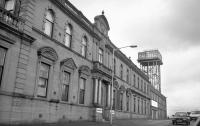
...
Bill Roberton //1992
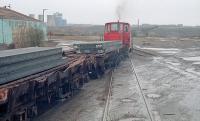
Ewan Crawford //1988

Ewan Crawford 29/03/2004
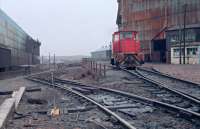
Ewan Crawford //1988
This box was on the south side of the West Coast Main Line at the point where the lines to the Dalzell Steel Works branched off to the north west. It replaced Colville's Sidings Signal Box (see entry for main details).
...

Network Rail /10/2022
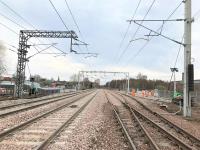
Network Rail //2023
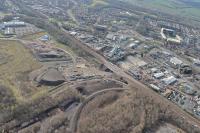
Network Rail /04/2023
This signal box replaced Windmillhill box (the name of the area to the immediate south) in 1890. The box was just north west of Flemington station and controlled access to two branches.
...
This two platform was to the east of Motherwell in an area of rapid industrialisation.
...

Ewan Crawford //1988
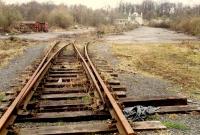
Ewan Crawford //1988
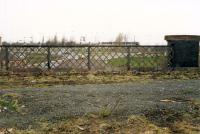
Ewan Crawford //1988
This steel works was opened by the Lanarkshire Steel Company Ltd in the 1890s and gradually expanded. The site had an open hearth furnace and rolling mills. It was served by two sets of sidings. From the north were sidings coming from the Motherwell New Lines (Caledonian Railway), built around the same time. That line, before its extension north, was essentially a double track headshunt ...
More detailsThis was a large junction and west end of a yard which commenced at Shieldmuir Junction to the east.
...
See also
Ravenscraig Steelworks (David Colville and Sons)
Motherwell New Lines (Caledonian Railway)
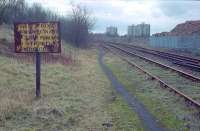
Ewan Crawford //1988

Ewan Crawford //1988
This is a minimal modern two platform station. The platforms are linked by a footbridge which predates the station. To the east is Shieldmuir Junction where the connection to Wishaw station leaves the line through Motherwell and the west end of the Royal Mail Scottish Distribution Centre loop connects to the main line.
...
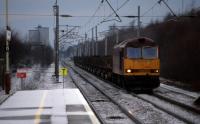
John Clark 31/12/2003
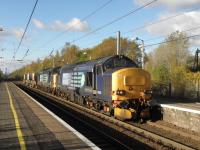
Jim Prentice 26/10/2012
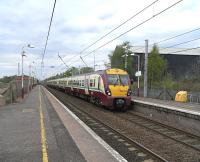
David Panton 29/04/2009
This is the junction where the single track to Wishaw leaves the main line south east of Motherwell station. The main line is double track, the connecting line is single track.
...
See also
Wishaw, Cambusnethan and Coltness Line (Caledonian Railway)
This was at the junction for the Wishaw Iron Works. This was one of the entries into the Wishaw Estate Railway. The works was served by that line from the north east.
...
See also
Wishaw Estate Railway
This was a two platform station. It was the first station in Wishaw.
...
This signal box was on the south side of the line between Wishaw South station (west) and Overtown [1st] station (east).
...
This was a two platform station. It was just to the north of Overtown itself. (Much closer than Overtown [2nd], to the north, which replaced this station and was closer to Waterloo.)
...
This junction was the location where the Wishaw and Coltness Railway (this portion opened around 1842) was met by the Caledonian Railway in 1848. The Caledonian used the W&C as part of its approach to Glasgow and to the north.
...
See also
Caledonian Railway
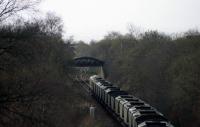
John Clark //2000
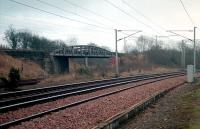
Ewan Crawford //1987
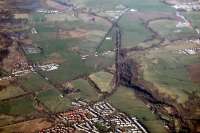
Ewan Crawford //
This signal box was located at the east end of loops, which began at Garriongill Junction (formed with the Caledonian Railway in 1848), and was at the incline foot of the single track Morningside Incline which ran uphill to the East North East.
...
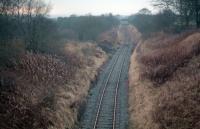
Ewan Crawford //1987
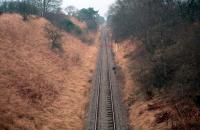
Ewan Crawford //1987
This station was on the west side of Stirling Road. The station may only have ever been called Carluke (or Carluke and Lanark), whether it remained open or re-opened after 1848 (the opening of the Caledonian Railway which actually reached Carluke) is in doubt. The Caledonian Railway, having subsumed the Wishaw and Coltness Railway called the goods station here Stirling Road.
...
This junction is closed. It was formed between the Wishaw and Coltness Railway and the line to the Coltness Iron Works. Serving this works was one of the main reasons for the building the Wishaw and Coltness Railway.
...
See also
Coltness Iron Works Railway
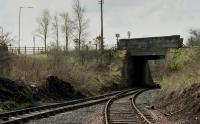
Bill Roberton //2001
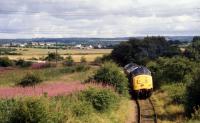
John Clark /08/1993
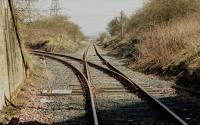
Bill Roberton //2001
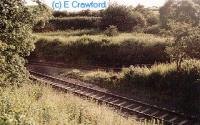
Ewan Crawford //
Established by Henry Houldsworth (1770-1853) in 1839.
...
See also
Wilsontown, Morningside and Coltness Railway
Coltness Iron Works Railway
Cleland to Morningside Line (Caledonian Railway)
A short section of line was relaid from Stirling Road Junction on the course of the former Wishaw and Coltness Railway in 2011 (this portion of line had closed in 1974 with the closure of Kingshill Colliery No 1).
...
This junction was formed in 1864 between the Cleland to Morningside Line (Caledonian Railway) and the 1844 extension to Morningside [CR] of the Wishaw and Coltness Railway.
...
See also
Cleland to Morningside Line (Caledonian Railway)
This station was on the west side of Morningside Road. It was effectively a terminus although a bridge over the road connected the line to the North British Railway's Morningside [NBR] station on the east side of the road. The station probably opened in connection with the new line to Newmains opened in 1864, passengers 1867.
...
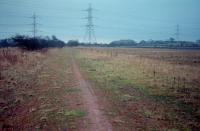
Ewan Crawford /12/1987
The Wishaw and Coltness Railway reached Morningside around 1844 from Carluke [1st] (reached 1842) - a short distance of around 2/3 of a mile. The extension was probably driven to reach the under construction Wilsontown, Morningside and Coltness Railway rather than a desire to reach Morningside itself. It did service the Chapel Colliery in passing.
...
See also
Wilsontown, Morningside and Coltness Railway
Books









